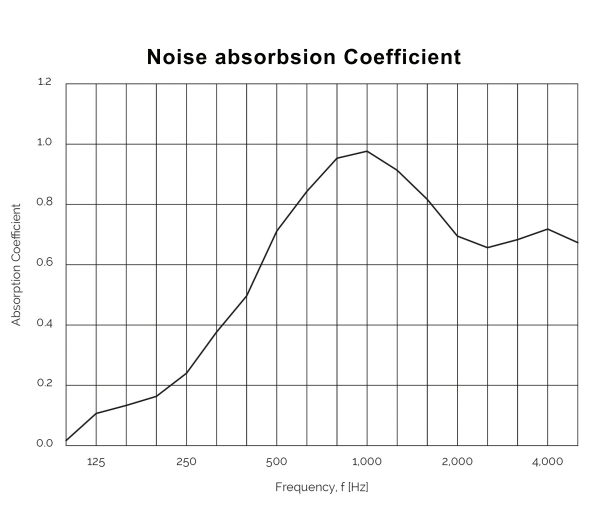What is the Noise Reduction Coefficient (NRC) Range for Polyester Fiber Acoustic Panels?
In architectural acoustics, selecting sound-absorbing materials is crucial for improving indoor acoustic environments. Polyester fiber acoustic panels, a common sound-absorbing material, are widely used in recording studios, conference rooms, theaters, and libraries due to their excellent sound absorption, eco-friendly properties, and decorative appeal. The Noise Reduction Coefficient (NRC), a key metric for evaluating sound absorption performance, plays a significant role in selecting and applying polyester fiber acoustic panels.
NRC Range of Polyester Fiber Acoustic Panels
The Noise Reduction Coefficient (NRC) measures a material’s ability to absorb sound energy across specific frequency ranges, typically averaging values at 125Hz, 250Hz, 500Hz, 1000Hz, and 2000Hz. A higher NRC indicates better sound absorption performance.
Polyester fiber acoustic panels generally have an NRC range of 0.7 to 0.88, with specific values influenced by factors such as material thickness, density, and surface treatment. For example, A 9 mm-thick panel may achieve an NRC above 0.7. Increasing the thickness to 18mm or more can raise the NRC to nearly 0.88, delivering outstanding sound absorption.
This high NRC makes polyester fiber panels highly effective at reducing echoes, reverberation time, and improving speech clarity, especially in spaces with stringent acoustic requirements.
Differences in High vs. Low-Frequency Absorption
While polyester fiber panels perform well overall, their effectiveness varies between high and low frequencies:
-
Superior High-Frequency Absorption
The porous structure of polyester fiber panels excels at absorbing high-frequency sound waves (e.g., above 2000Hz). Short-wavelength high-frequency waves easily penetrate the micro-pores, where friction with the fibers converts sound energy into heat. Thus, high-frequency NRC values often approach the upper limit of the panel’s range.
-
Relatively Weaker Low-Frequency Absorption
Long-wavelength low-frequency waves (e.g., 125Hz, 250Hz) struggle to penetrate deeply, leading to more surface reflection and lower absorption coefficients. For instance, a 9mm panel may only achieve an NRC of 0.3–0.5 at 125 Hz.
-
Improving Low-Frequency Performance
Increasing panel thickness or using specialized designs (e.g., perforations, textured surfaces) can enhance low-frequency absorption. For example, 18 mm+ panels or those with air gaps behind them significantly boost low-frequency performance, making them suitable for venues like concert halls or cinemas.
How to optimize the sound absorption performance of polyester fiber Sound-absorbing Boards?
To better leverage the sound absorption effect of polyester fiber sound-absorbing boards, the following aspects can be optimized:
1. Choose the material thickness reasonably
Select the appropriate thickness of sound-absorbing boards according to the acoustic requirements of the site. For instance, in places where strict control of low frequencies is required, thick plates of 18mm or more can be selected. For general meeting rooms or classrooms, thin plates ranging from 9mm to 15mm can meet the requirements.
2. Adopt a composite structure
Combining polyester fiber sound-absorbing boards with other materials (such as air layers, perforated plates) to form a composite sound-absorbing structure can significantly enhance the low-frequency sound absorption performance. For instance, leaving an air layer of 50mm to 100mm behind the sound-absorbing board can effectively enhance the low-frequency sound absorption effect.
3. Surface treatment process
The surface structure of the sound-absorbing board is changed through processes such as drilling, embossing, and engraving to increase the contact area between the sound wave and the material and improve the sound absorption efficiency. For instance, the sound absorption coefficient of perforated sound-absorbing boards in the high-frequency range can be increased by 10% to 20%.
4. Scientific layout and installation
Plan the installation position and area of the sound-absorbing board reasonably to avoid excessive sound absorption, causing the sound field to be too “dry”. For instance, in a meeting room, sound-absorbing panels can be installed on the walls and ceiling, but some reflective surfaces can be retained to balance the sound absorption and reflection effects.
Conclusion
Polyester fiber acoustic panels have become the “star material” in the field of architectural acoustics due to their excellent sound absorption performance, environmental protection features, and decorative effects. Its NRC value is usually between 0.7 and 0.88. Its high-frequency sound absorption performance is significantly better than that of the low-frequency range. However, by reasonably selecting the thickness, adopting a composite structure, optimizing the surface treatment, and scientifically arranging the installation, the low-frequency sound absorption effect can be effectively enhanced to meet diverse acoustic requirements.
In practical applications, it is recommended to select the appropriate polyester fiber sound-absorbing board products based on the specific acoustic requirements of the site and in combination with professional acoustic design to create a comfortable and efficient acoustic environment.



